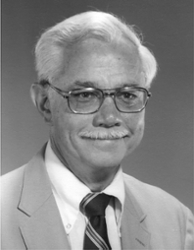

|

|
IN MEMORIAM
William Louis Garrison
Professor, Civil and Environmental Engineering, Emeritus
UC Berkeley
1924 – 2015
William Louis Garrison was a Professor and later Professor Emeritus of Civil and Environmental Engineering and Emeritus Research Engineer in the Institute of Transportation Studies, University of California, Berkeley. He died on February 1, 2015, in Lafayette, CA, at the age of ninety.
Garrison came to Berkeley mid-career. He served as a meteorologist during World War II and then took advantage of the GI Bill to earn bachelors and masters degrees from Peabody College in Nashville, Tennessee. In 1950 he received a Ph.D. in geography from Northwestern University in Evanston, Illinois. In addition to working in geography and civil engineering, he was a truck driver, surveyor, and mechanic.
Somewhat of a job hopper, Garrison held positions at the University of Washington, Northwestern University, University of Pennsylvania, University of Illinois, and University of Pittsburgh, as well as the University of California at Berkeley. During the 1950s he was a Lecturer in the Brookings Institution's Urban Policy Program. In 1973 he joined Berkeley’s Department of Civil and Environmental Engineering and that same year was appointed director of the Institute of Transportation and Traffic Engineering (ITTE). As a geographer, he is best known for instigating the Quantitative Geography revolution, and as an early leader in the development of the new field of Regional Science. As a geographer at the University of Washington, he advised a slew of students who went on to become significant geographers in their own right, including Brian Berry, Duane Marble, and Waldo Tobler, among other students, who were collectively dubbed the “Space Cadets". His pioneering 1958 "Studies of Highway Development and Geographic Change" was one of the first empirical studies of the effects associated with the Interstate Highway System.
He migrated from geography to transportation in the 1960s. He had particular interest in innovation and how technological change occurs. He strongly believed that we should be seeking new development pathways, rather than being stuck perfecting existing systems (what he called the “polished present”). He also spent time in Austria (1988-89) examining growth trajectories of various transportation technologies. Much of that work is what forms the nucleus of The Transportation Experience (co-authored by David M. Levinson; Oxford University Press, 2006; 2014, 2nd edition), a history of transportation over the past two centuries. He is one of the few people to take a macro-view of transportation, and who tried to understand the long-term dynamics of systems. In 1987 he organized the first US conference on Intelligent-Vehicle Highway Systems, what today is called Intelligent Transportation Systems. With Jerry Ward he wrote Tomorrow’s Transportation: Changing Cities, Economies, and Lives (2000), presenting alternative technology paths. He remained influential even after retiring from the University of California, Berkeley, teaching through 1996 and writing on transportation topics through the 2000s.
William Garrison’s research and teaching focused on finding mathematical descriptions of human settlement and movement patterns. Despite his emphasis on rigorous analysis and systematic description of human behavior, he was always interested in applying those patterns to the development of public policy. There was creative tension in his teaching between simple but precise explanation and the use of a wide variety of tools drawn from the social sciences for interpretation. He was frequently drawn to new ideas, for example general systems theory, and explored with his students how they might be applied to policy. He asked his students to arrive at clear statements of their research findings and then immediately challenged students to place them into messy contexts of conflicting perceptions, politics and human institutions.
Garrison served the Berkeley campus in a variety of roles, including as Director of the Institute of Transportation Studies in the 1970s. His leadership was reflected in the institute’s name change from ITTE to ITS. This was a period of great transformation for the field of transportation, as it evolved from a focus on design of facilities to transportation systems planning, and from a single-mode analysis to a multi-modal perspective that integrated economics, systems analysis, and policy with engineering.
One of Garrison’s students, Professor Martin Wachs writes: "The pull and tug between analysis and application - between science and politics - was his greatest contribution to my career. He opened my eyes to the challenges of contradictions between research and policymaking which have influenced my work over fifty years. My debates with him over the applicability of what I was learning were enjoyable when I was young and widened my horizons in many ways that I appreciate every day."
Garrison is survived by his wife Marcia Garrison and their four children, Deborah Church, James Garrison, Jane Garrison Grimaldi, and John Garrison; his three children, Sara Garrison, Ann Darrin, and Helen Saxenian from his first wife Mary Margaret Garrison (she predeceased him); sixteen grandchildren, and one great grandchild.
David Levinson
Martin Wachs
Samer Madanat